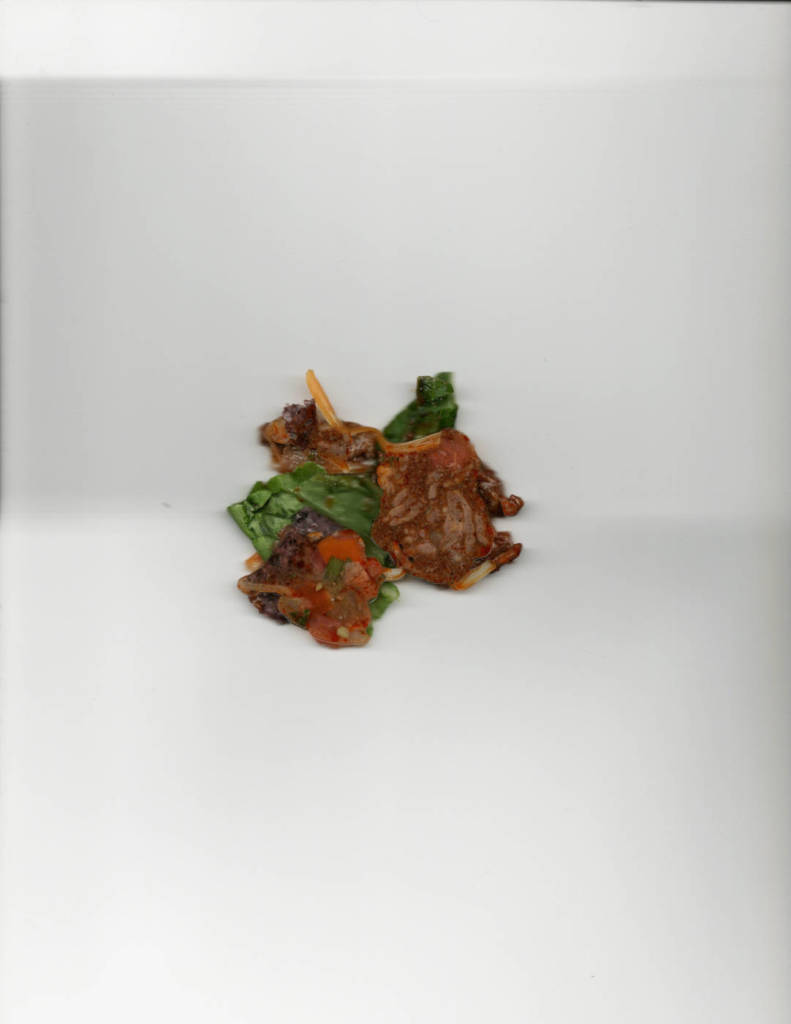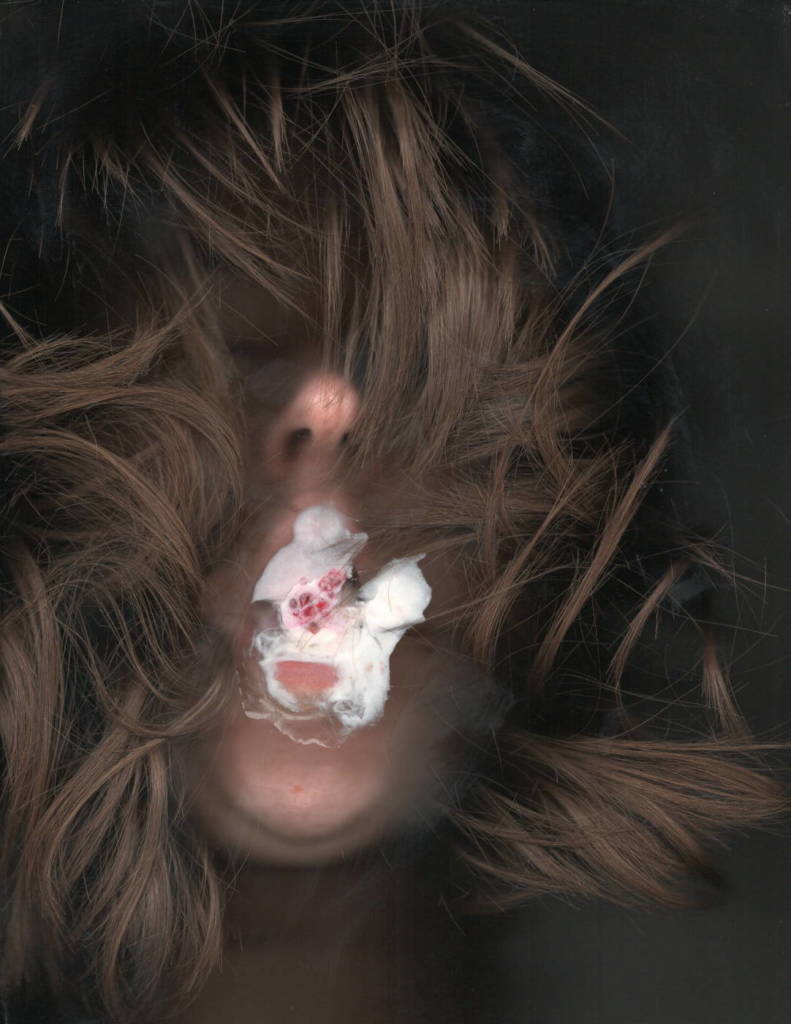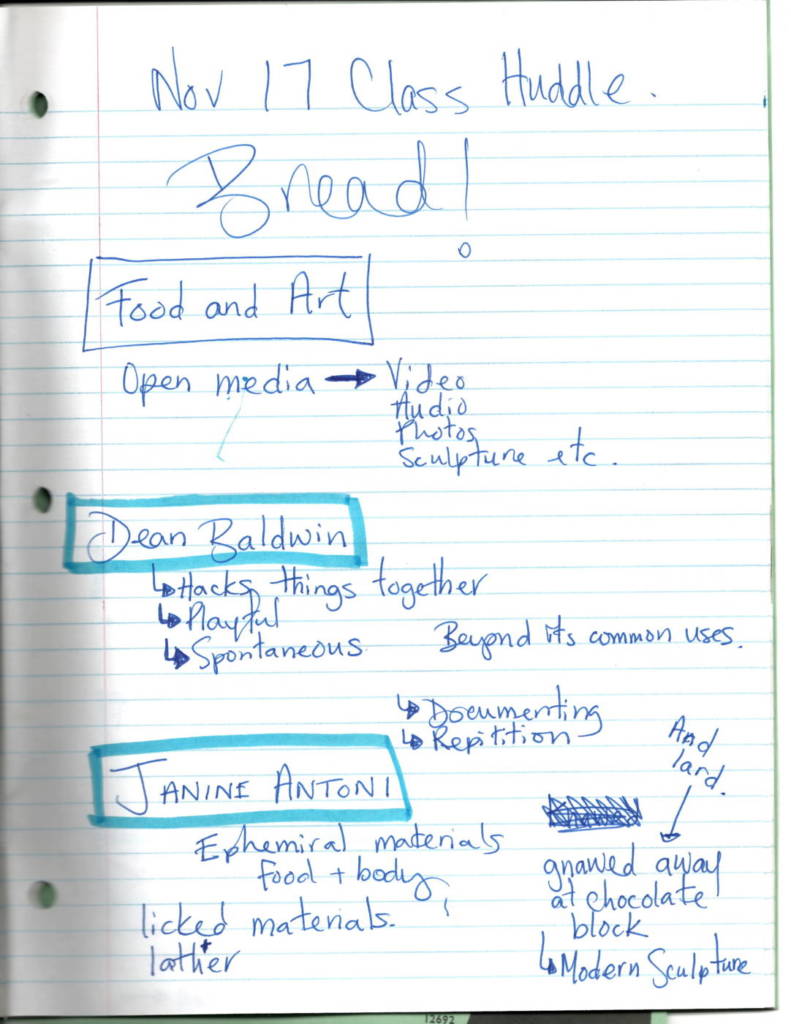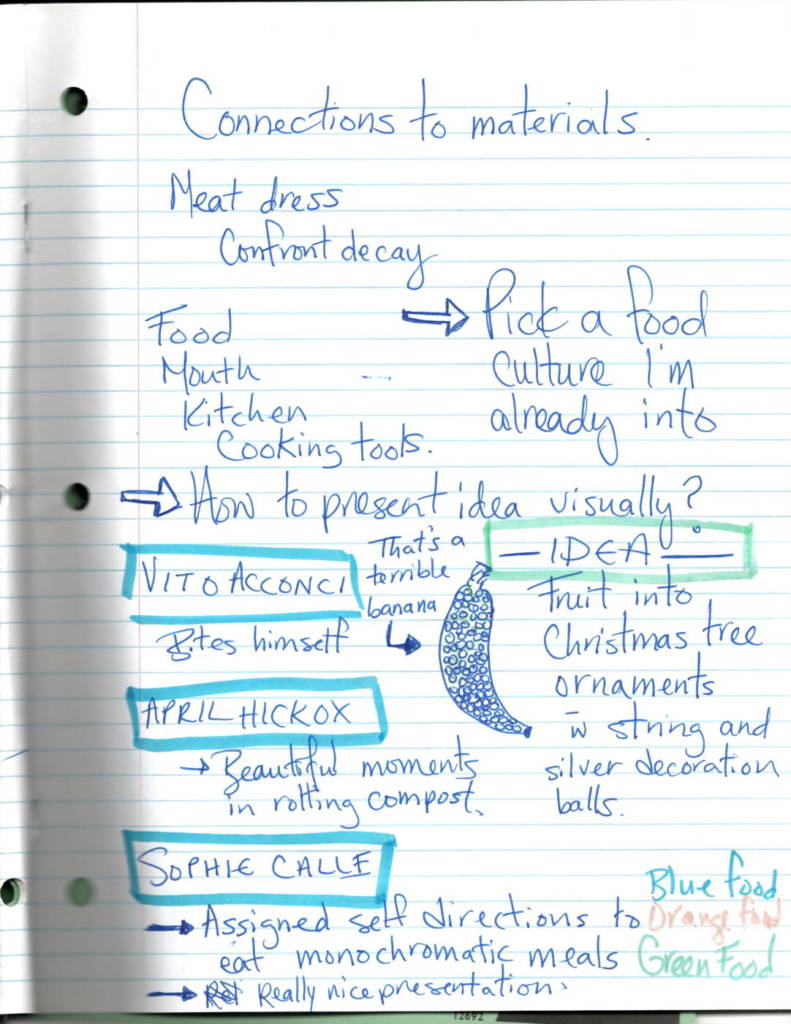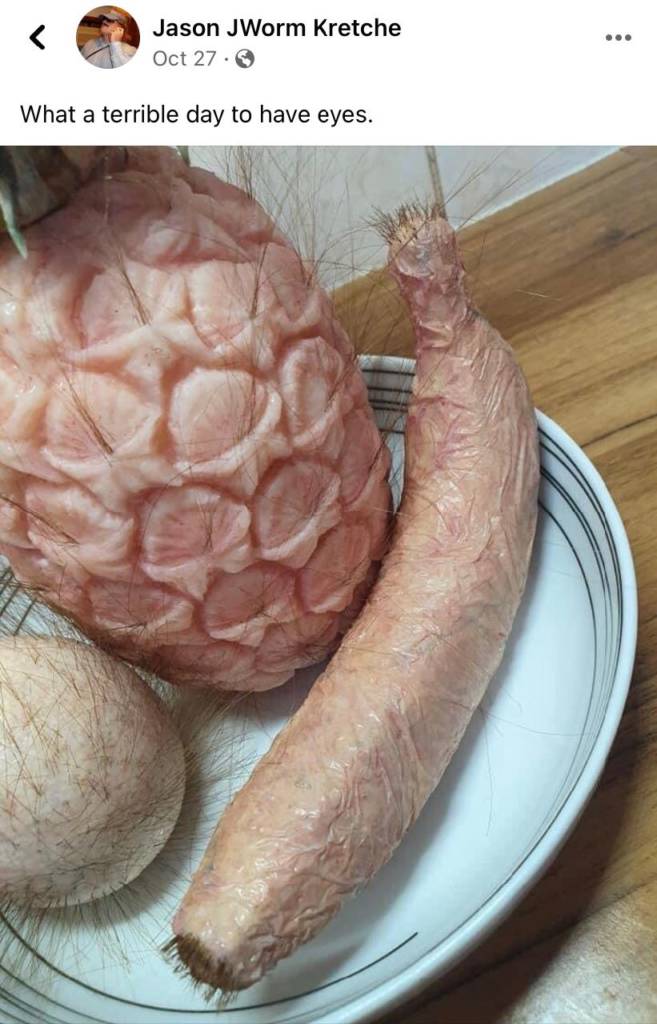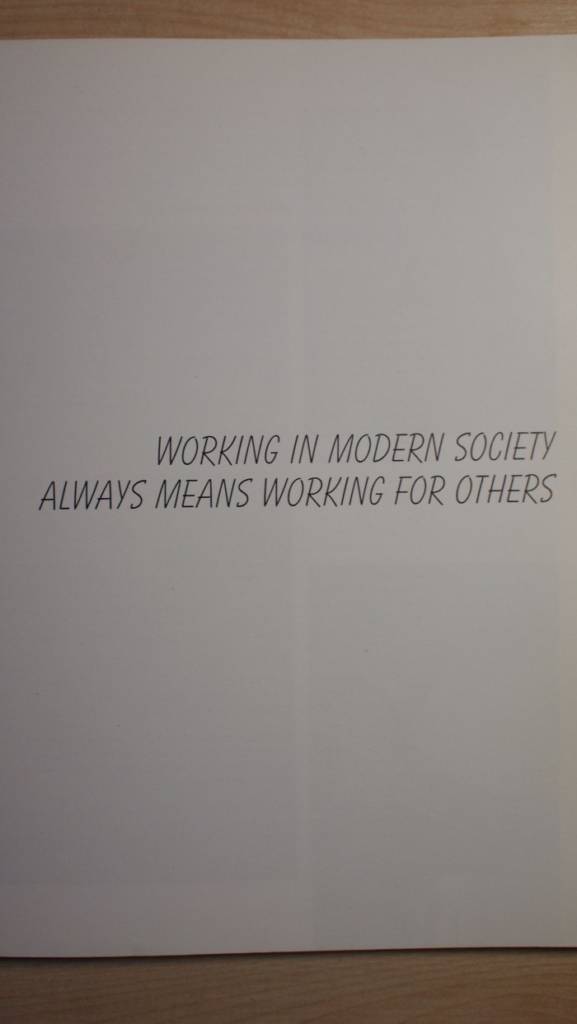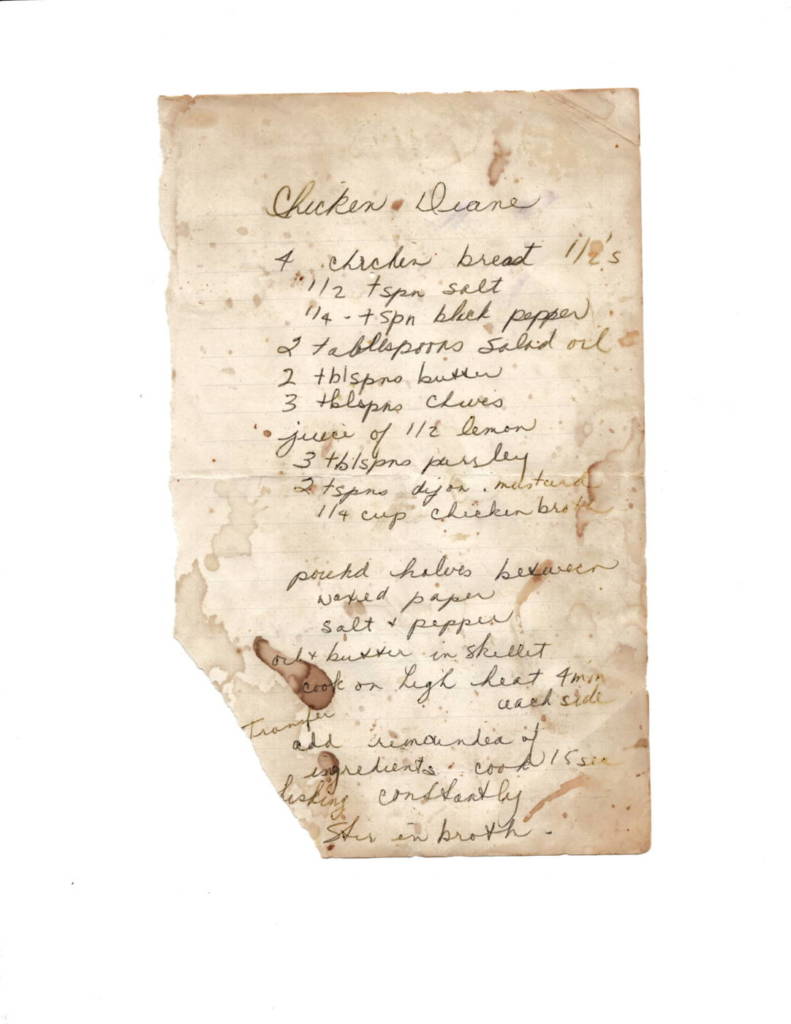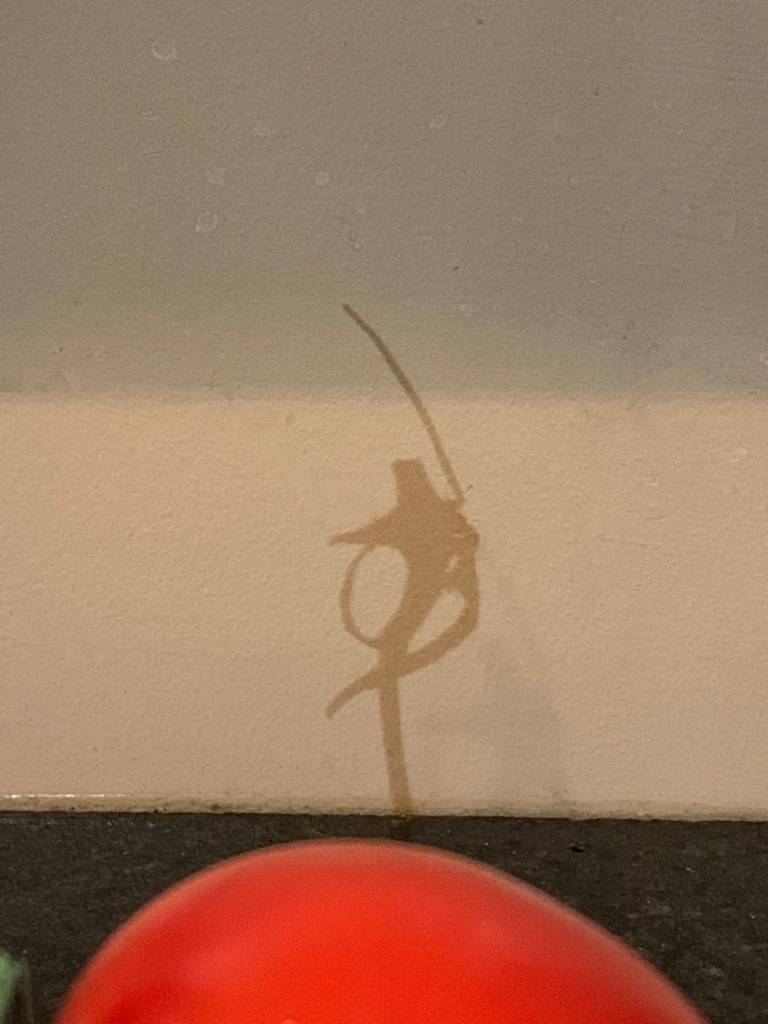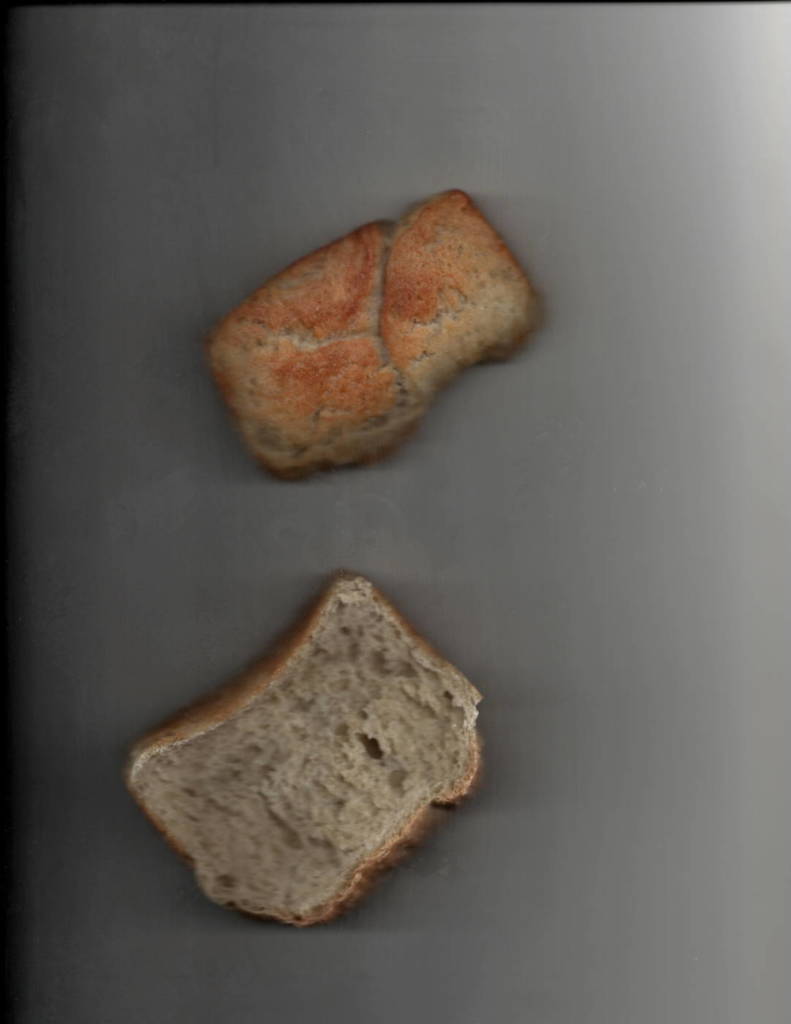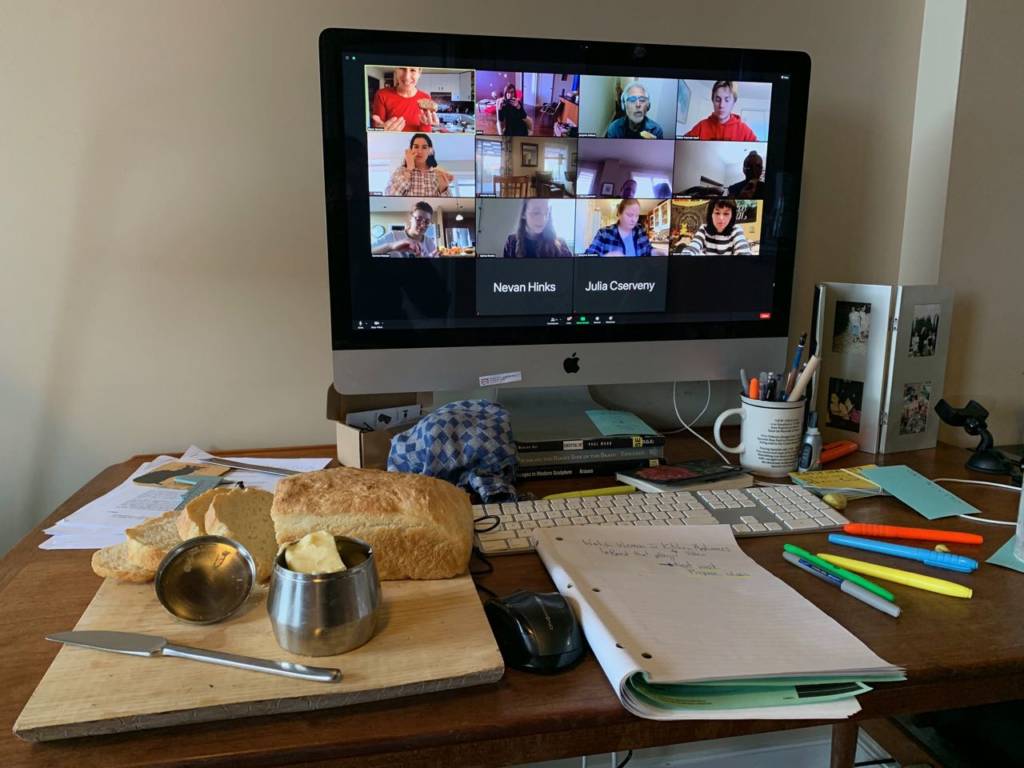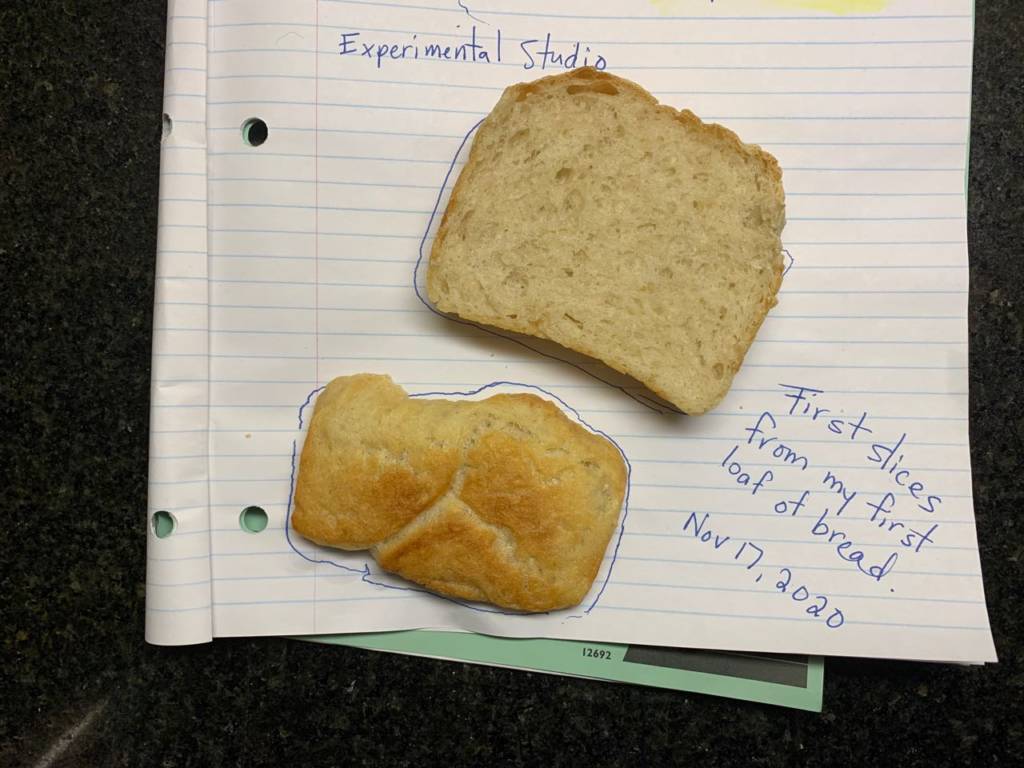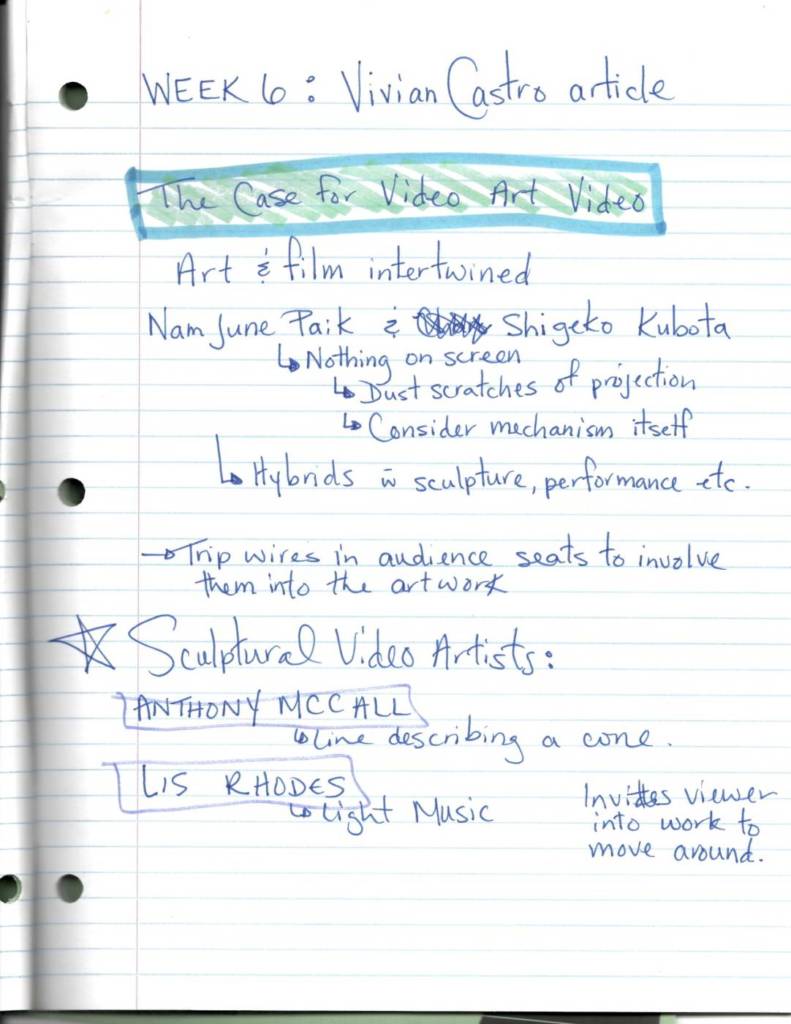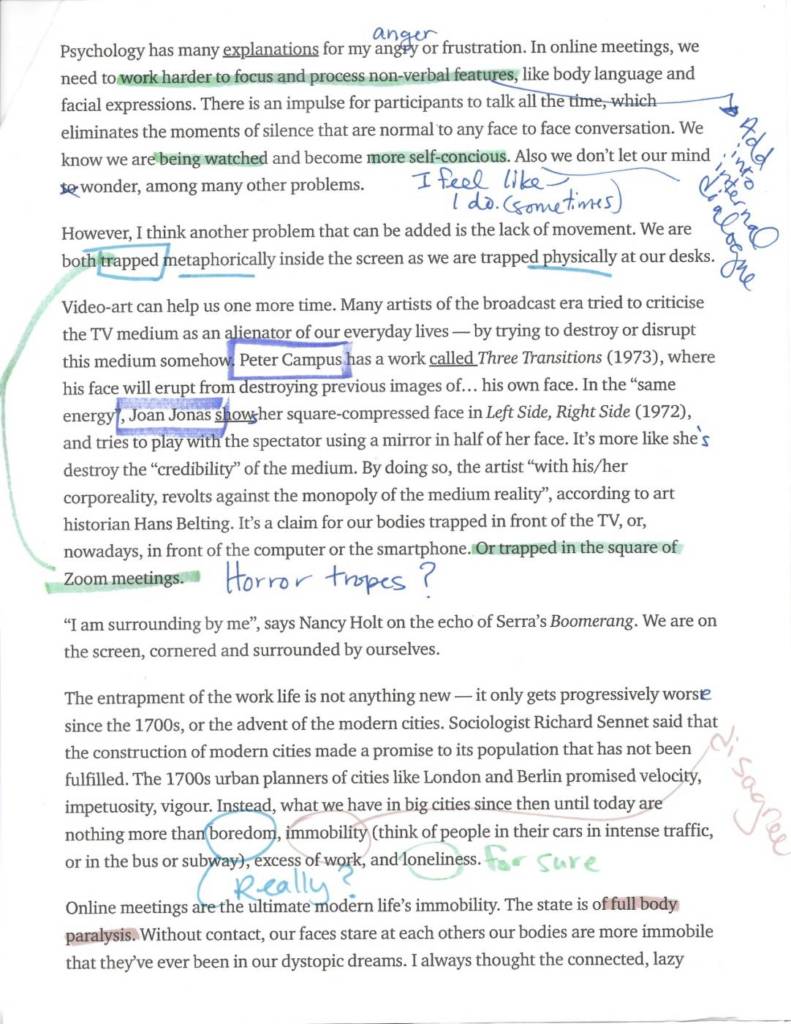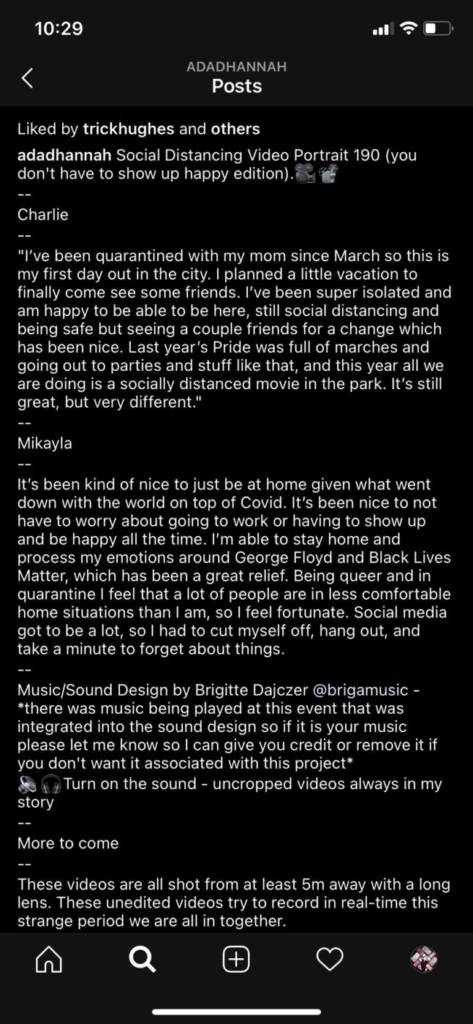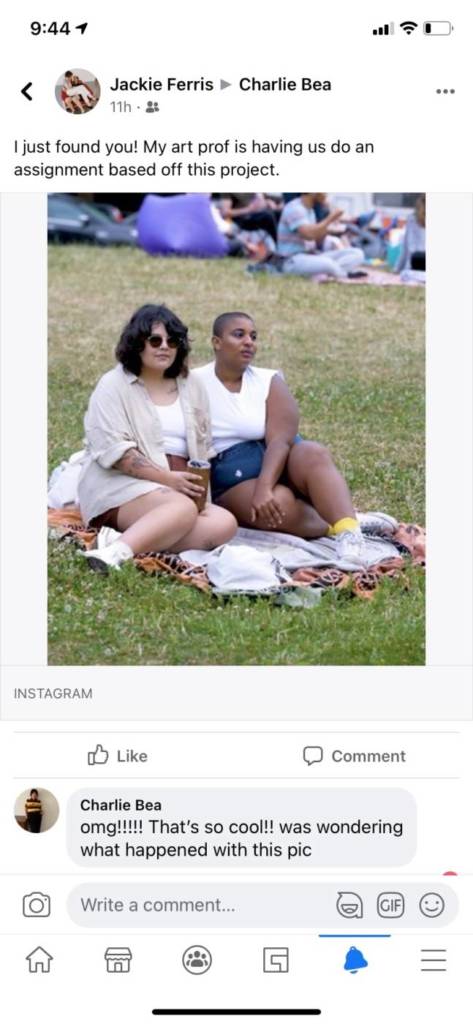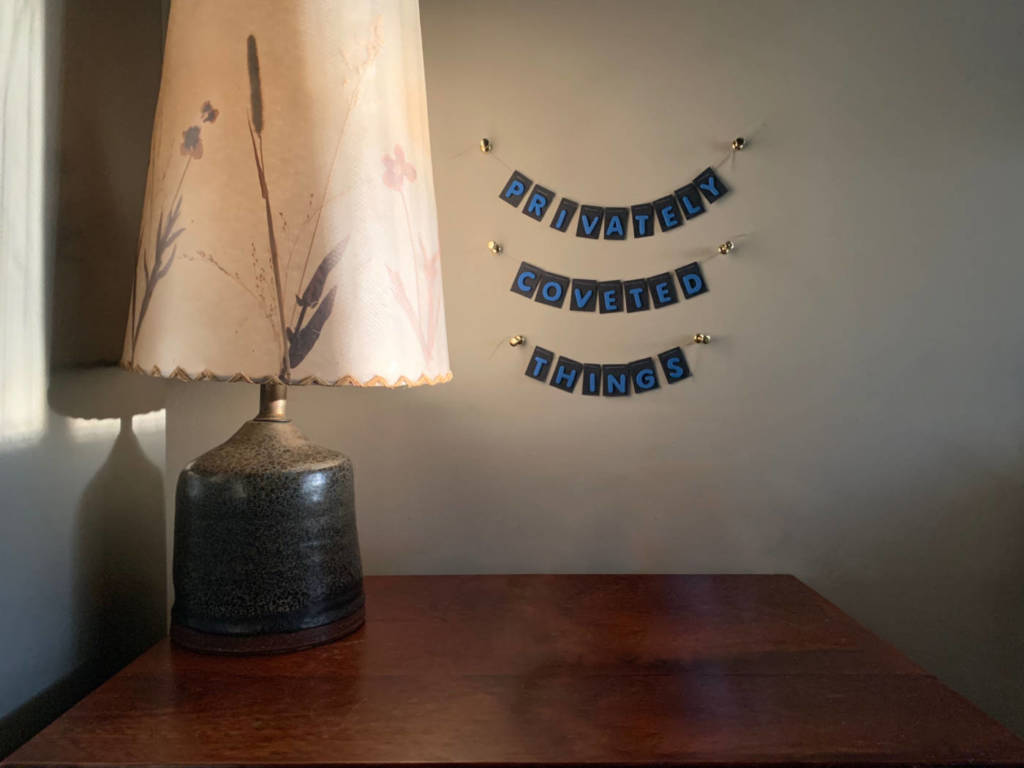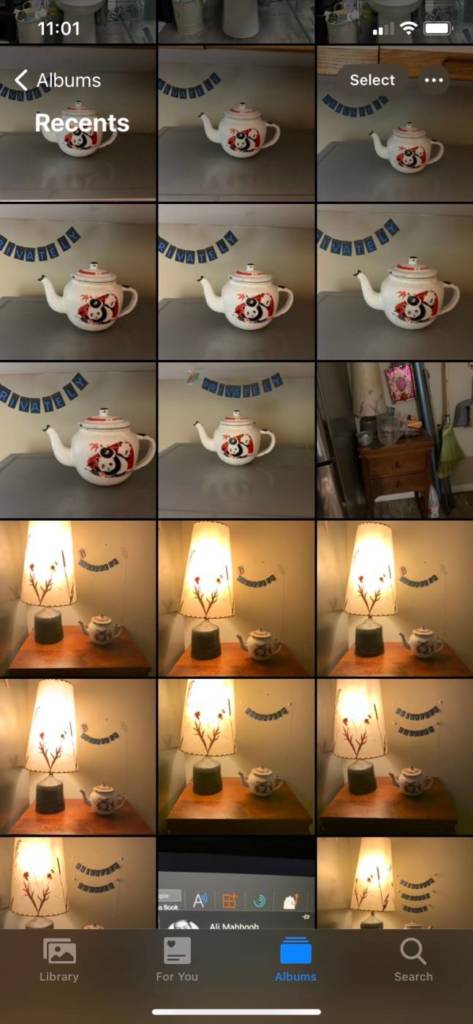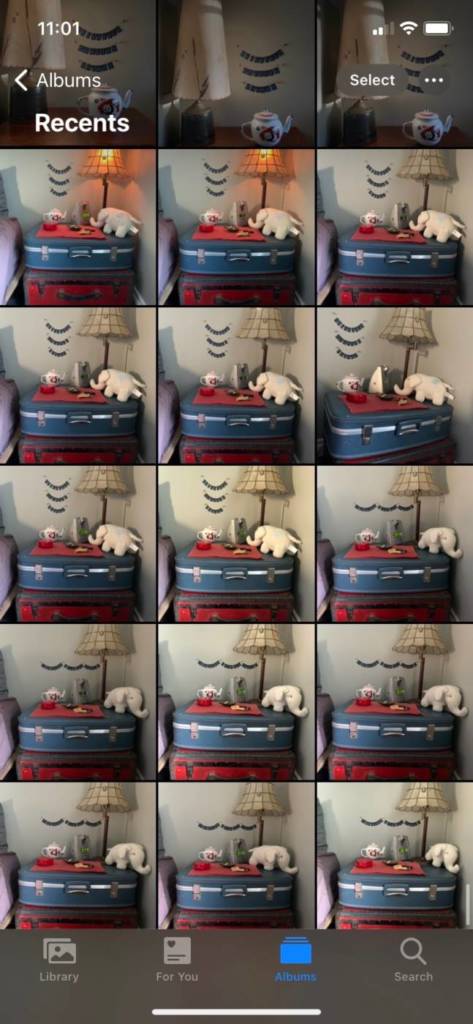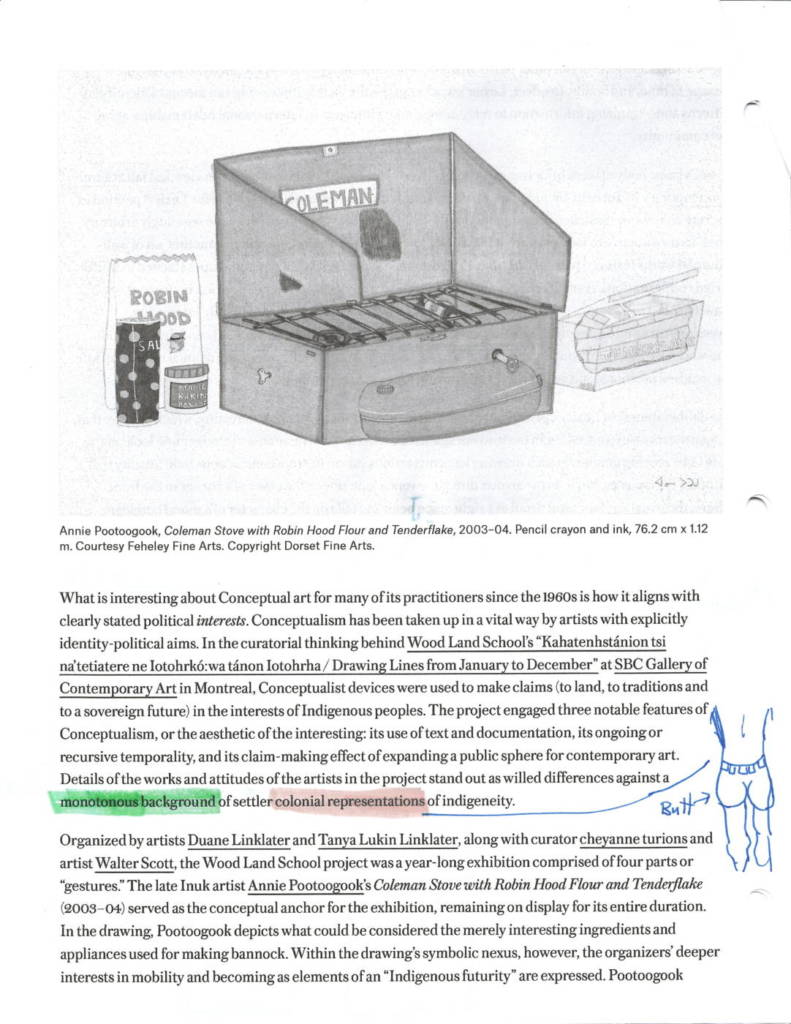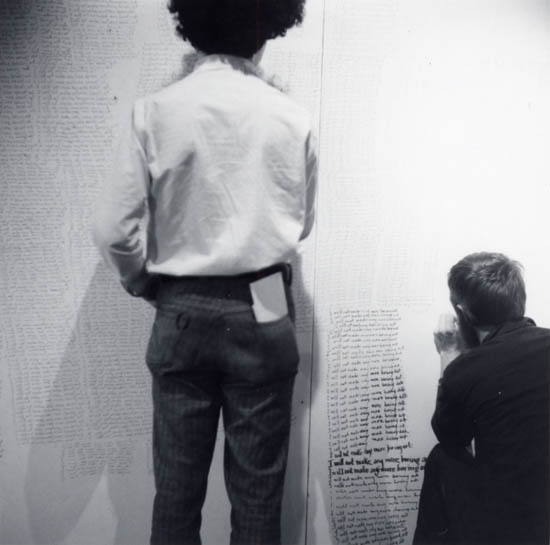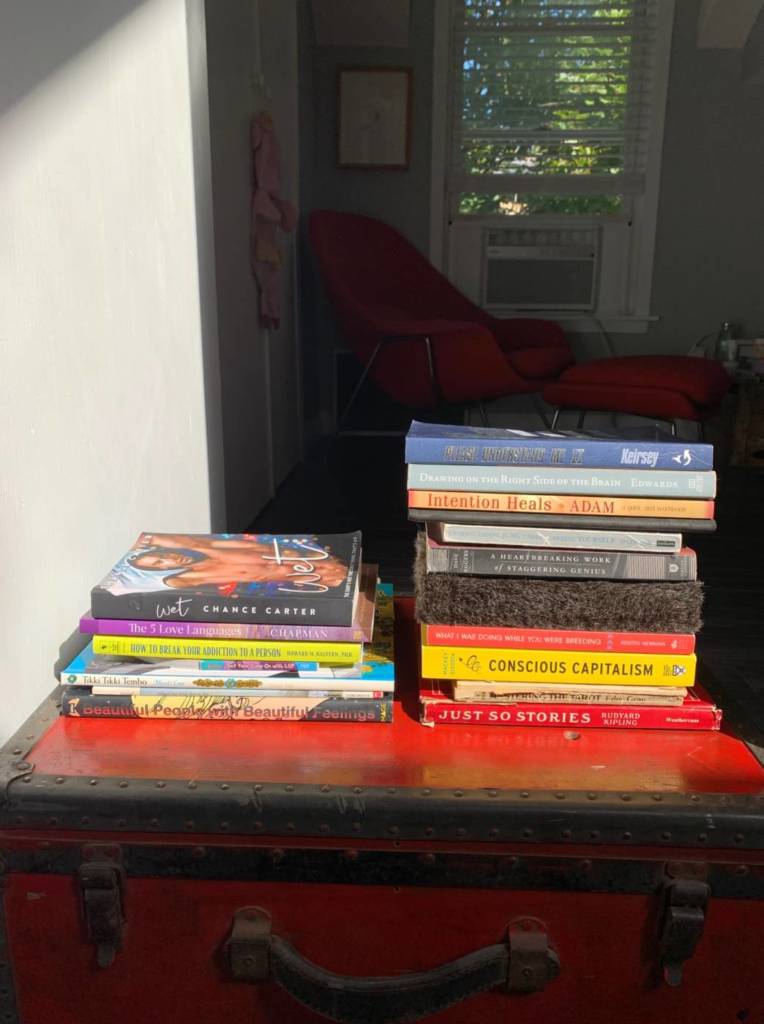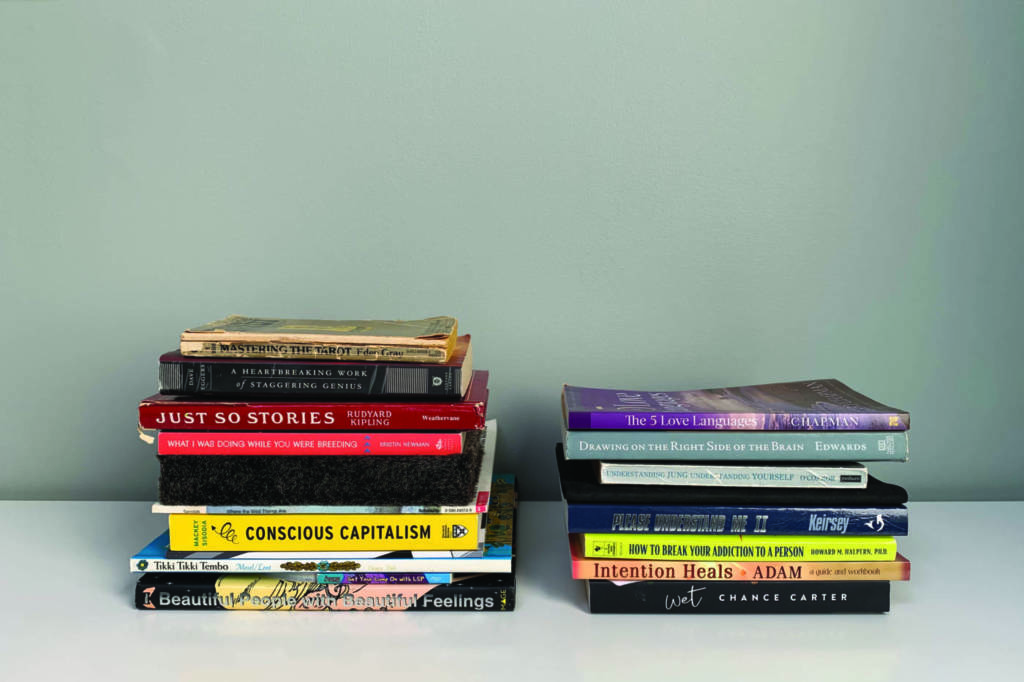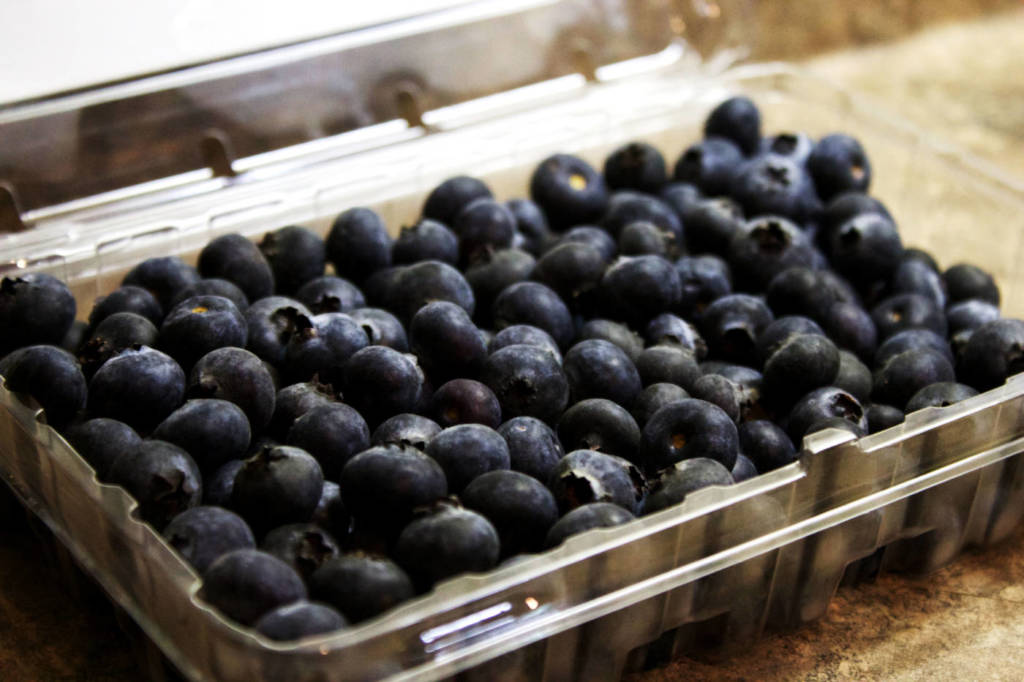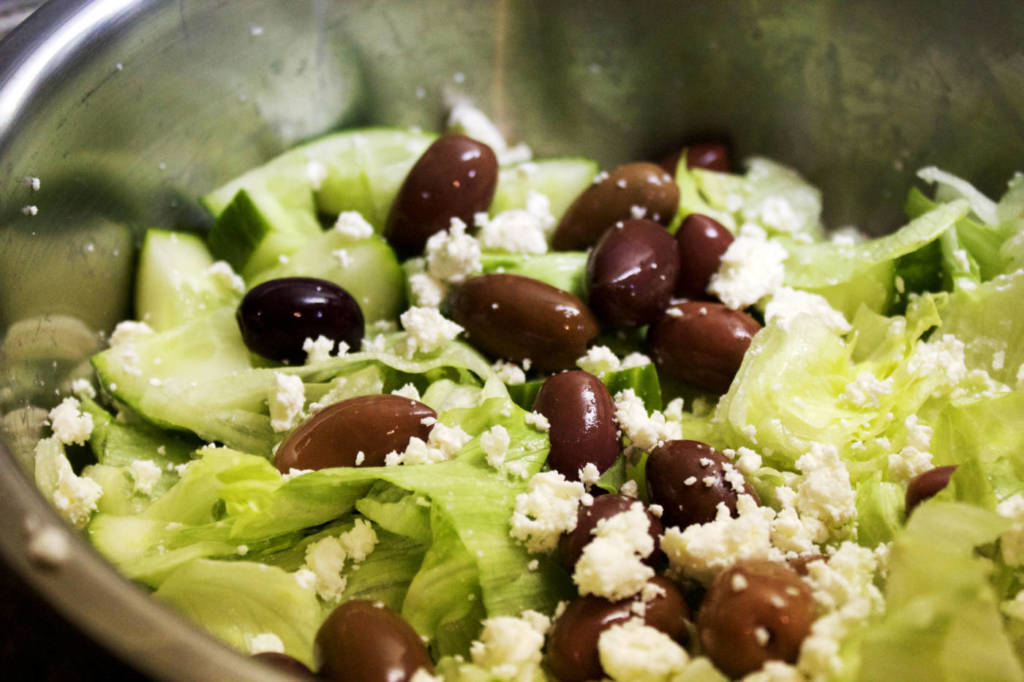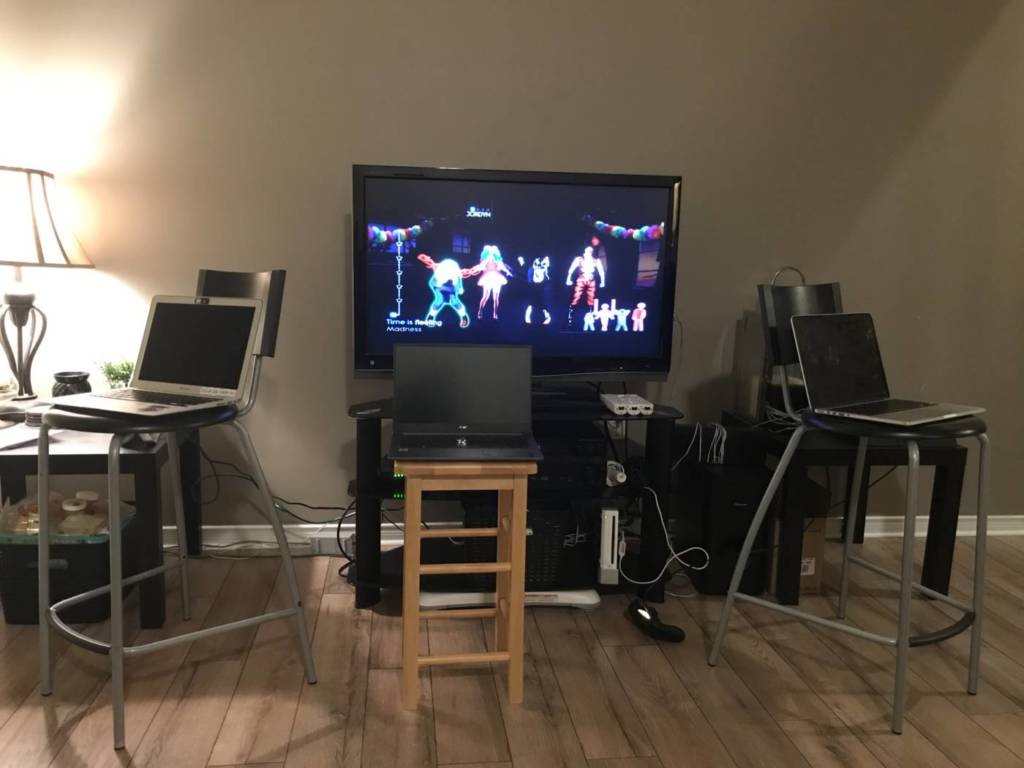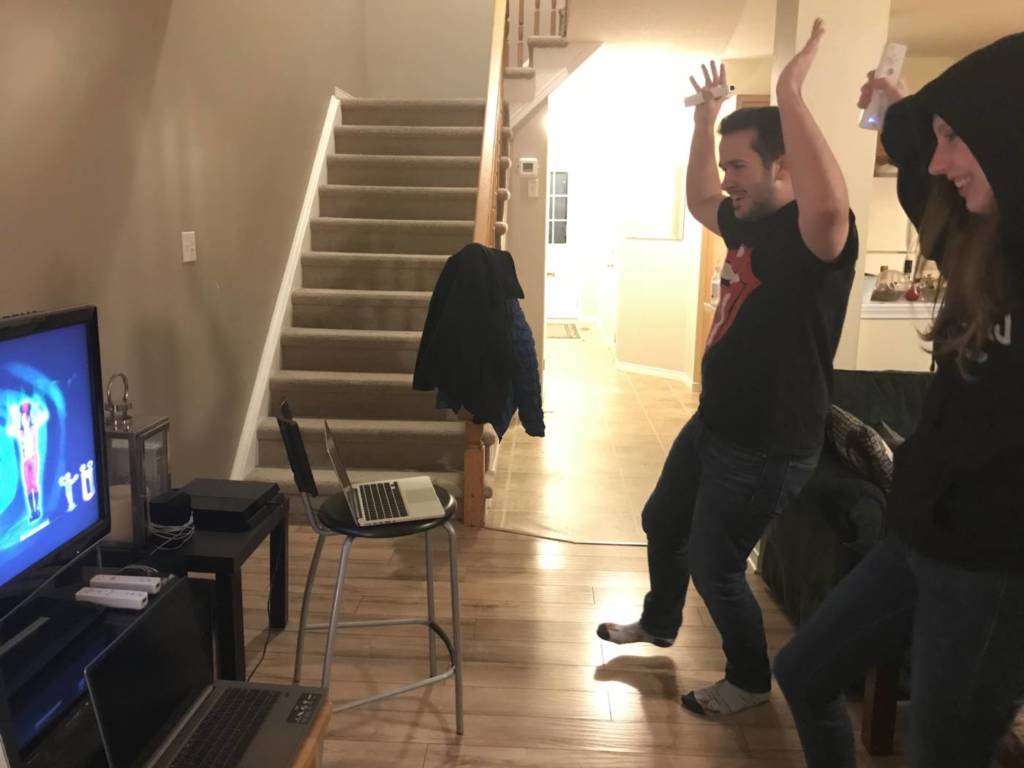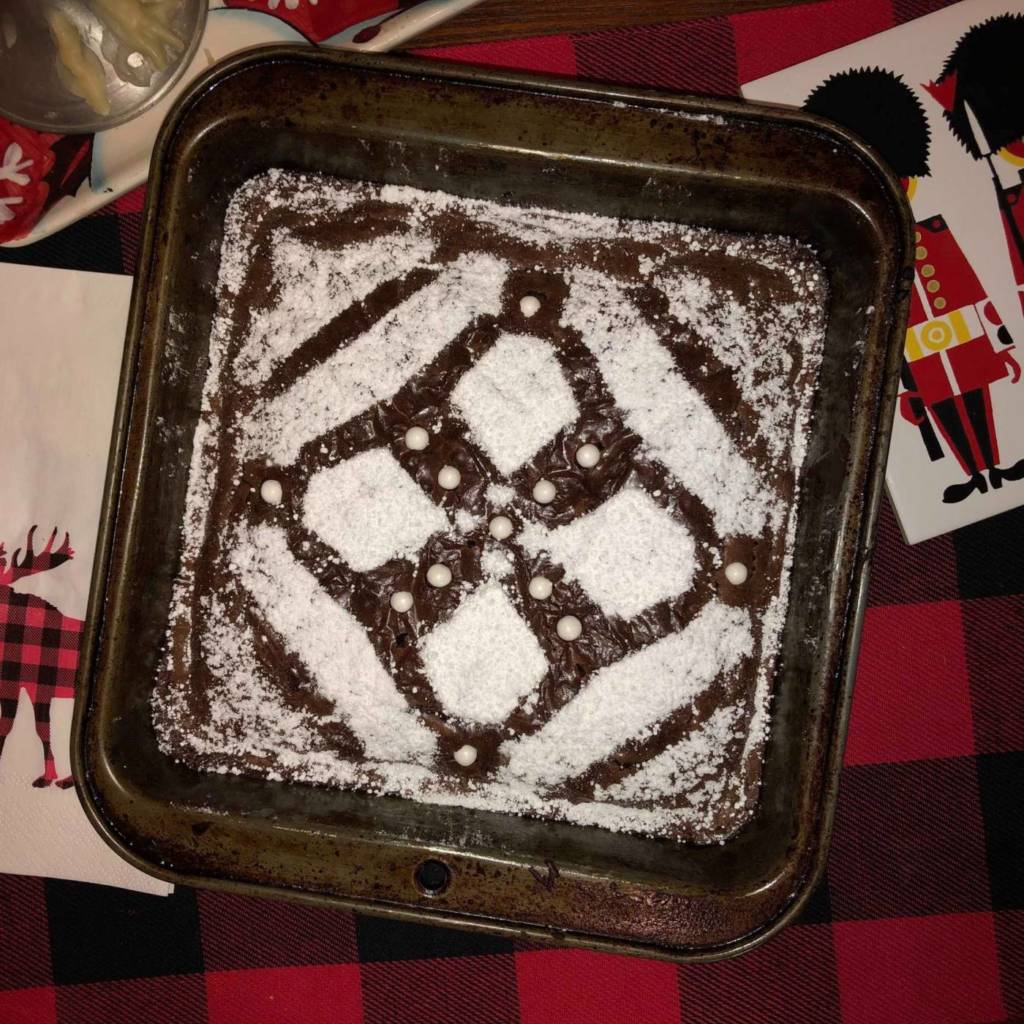
ASSIGNMENT 7 – FOOD ART FINAL
REVIEW OF CLASS COMMENTS ON PROPOSAL:
- Hands only, have a shot from the side or above…
- Have your mom teach you what her mom taught her. Photos and uncut video.
- I really enjoy this idea… Going to experiment with this idea. Simple yet not a story being told.
Final Food Project
- I included louder sounds like the hand mixer and the water from the sink because I enjoyed the closeness that the figure came to it.
- I wasn’t going to include the awareness to the camera but since is two people in a space I thought that since its a shared experience and storyish piece, I thought that it was additive rather then subtractive.
- Used a tripod and kept the camera steady at one view point. Camera was angled down to see hands and parts of body.
- My grandmother has used the same cutters for years, since my mother was a child. Only recently has she changed shape, I think she lost them.
- Video is 10:36 minutes long.
- Double click to enter full screen. file too large to post on WordPress, it is linked to youtube.

ASSIGNMENT 7 – FOOD ART
Reflection on in class videos
Out of the video presented to us during class and on WordPress I found the storytelling aspects of Rod, Bernie, Peggy and Aislinn to be the most intriguing.

- Last year in Sculpture 1, I was working on a project about Toronto/East York as a geographical location and how the Danforth and its decent into the Don Valley used to be just a large dirt hill. I had found old photographs posted on blogTO that had these wonderful scenes of what my part of Toronto looked like between 1908 and 1965.
- https://www.blogto.com/city/2012/11/what_danforth_avenue_used_to_look_like_in_toronto/
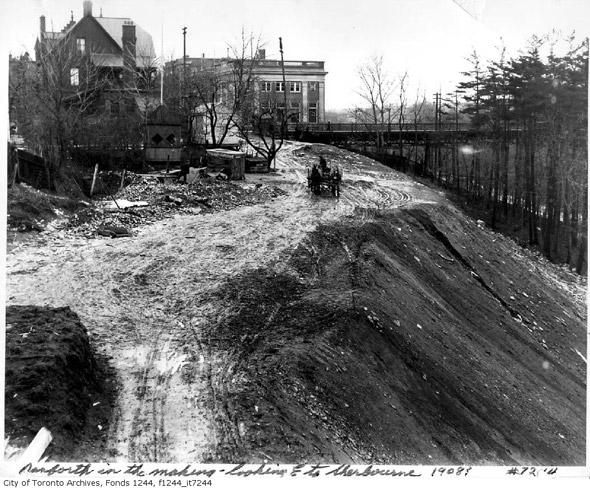
- From these photographs, I dove deeper into my specific area and tried to find information about the Sammon (my street name) Farms and the Italian flower farmers who lived in the houses, mine included, that were rolled up from the Danforth from on logs with horses to make space for the building fo the Danforth.
- This history of Toronto and my house included still sparks interest… I thought it would be a great story to tell while making something a cake or food with local ingredients.
- My second train of thought after watching and listening was thinking about my grandmother. we have a tradition in our family to either make shortbread cookies or rum cake with Barbados rum, she lived there for over 25 years, and my mother/aunt lived in Jamaica and Guyana growing up, it has a special place in all of our hearts.
Proposal Ideas
- Retell the stories or a story from either the construction and neighbourhood building of Toronto or center the story around my family and baking of the cake/cookies.
- Reflection on my last video project, I liked the idea of telling a story not using my face, I want to push using different body parts such as my hands doing the mixing and rolling out of the materials. I mentioned in the reflection on the bread podcast that the instant part of instant yeast took away the work and effort it takes to bake, that the tradition of making bread in general is lost. I want to really focus on the effort of my hands and body.
- I will be using local ingredients and sourcing them from mom and pop stores not big grocery stores, other then the rum of course. I will be measuring tools but staying away from the metal and sticking to wood and painted ceramics.
- I hope to shoot using at least a couple different angles then edit together. The idea of wanting these baking moment to be collaborative and messy, I an hoping my mother will join me in this endeavor both using voice and her hands, and ending the assignment’s video with a short reaction from my grandmother (if she can figure out the technology).
- I love the tranquility of the story teller and the nicely framed shots with natural lighting. My video will surly have louder moments and laughter but I would like the video structure to be the same. Not only for this project but also for my wellbeing and building stronger relationships with my family, these moments/activity will bake more meaning to myself and hopefully the peers on my class.
ASSIGNMENT 6 – THE RISE AND FALL OF BREAD: REFLECTION
- Notes on Podcast – CBC | The Rise and Fall Bread & my own experiences: Bread is historical. The context of when, where and whom it’s made with is extremely important. How one makes the bread shows tradition, culture and technique that vary by geographical location and how much the ingredients were available.
- While listening to the podcast I understood that for the first half they were talking about how to make bread and the different religions that used bread as a symbolic object for the sharing of christ, but I was more interested in when the narrator called it ‘the rise’ then its unleavened bread.
- Similar to making any dish in the kitchen, bread is communal in its making and eating. When making a test loaf before class (Nov 13th – Picture of test loaf below), I still needed another set of eyes to read instructions and help hold the bowl then mixing the dough together.
- At 16:10, a person is speaking about the meaning behind the ingredient, how yeast means patience, etc. For future bread, that I now know how to make, I think I will stay away from instant yeast. To really understand a material you need to put time and effort into its process, for this upcoming class and the bread loaf is something for us to share together but it does take away the meaning of the time and physical energy it takes to kneed with our hands and time to its and watch the yeast bloom, when connecting the ideas/activity back to the podcast.
- I agree with the idea of leaving Eden and putting in work and effort, even when making bread and sourcing ingredients, takes work. Like taking the subway to find instant yeast or mixing in the till you arms hurt. Although it’s not the same as sourcing from raw material and grinding them to the right consistency, I would like to think all bakers, new and old have the same amount of concentration and attention put into the making.
- A point that surprised me was the historical points made around 23:00, how women had more babies, due to a high infantile death rate- they would give the new babies bread to suck on for nutrients instead of milk so the women can have more children for the family. This story/fact is both understandable due to the it’s social and historical context, yet, just for a moment I got the feeling of, knowing more about the history as also made me want to know less, as a female myself… Just an interesting thought that came through while listening.
- My favourite quote: “When you plunge your hands into the kneading trough, even if you are working with a machine, and you feel the flour around your fingertips, you commune with the flour, you- it has a sensuality a vivacity a viscerality.”
- Before starting the podcast I really didn’t think much about the actual eating of bread. I just thought it was the moment around the event of dinner or buying freshly made that I liked so much. Although growing up there have been a couple of defining moments.
- The church I grew up in we used the circular disk bread with an embossed cross symbol, until Father David decided to bake bread every Sunday morning before service. He knew that I really liked the recipe so much that he would save the crust for me. I was the only youth that attended the church at that time and someone had to eat them, waste not, want not. As I got older I did attend less due to school and extra curricular activities. I was saddened to find that after he retired, they stopped making his recipe. I guess after thinking about that fond memory of the person and the place I still call a second home, It’s not just just the experience I have in that location but the bread itself that I have ties to.
- I was at camp, a music camp that I wasn’t very fond of but I developed a nice breakfast tradition by sitting with the pianist. He taught me that toast has to be perfect and should not sit on a plate when you take it out of the toaster. They need to breath and maintain a crispiness on both side, have then leaning on your salt shaker in the morning until you are ready to butter them. I still do this now and often remember his words.
- As a child, even now, I have been very fond of Pea Soup, green or yellow, It was co commonality that with any heavier soup in the winter we would either have bread to help eat it with or make grilled cheese, I still find that without a starch some dinners feel incomplete. We mainly use either a baguette or rye bread to complement the main course.
- When my parent was living in Paris for school, since she didn’t have a lot of spending money she would go down to the bakery really early in the morning and wait by the back door, she had make friends with one of the staff and he always gave her the runoffs or halved pieces for breakfast. If she had more money that day she would splurge for a chocolate croissant.
- My grandmother lived in Barbados for at least 25 years, almost every Christmas we would head down to visit her, we would spend days at the beach, since she got herself a membership to a yacht club in the last few years she was there we made it a tradition to order cinnamon sugar toast with tea in the afternoons. They were cut into soldiers, which was also my favourite as a kid, and the best thing I had all day, besides ice cream of course. I always asked to have the last piece. Since she moved back to Canada to be closer and, us stopped going a few years before, I don’t think we continued that tradition since. It’s something I miss that now remembering hopefully I can find a way to replicate it here.
- On the topic of the pandemic: People were home, all of us were at home, the ones who could be, there was time, people spend much more time online surfing the internet for things to do besides Zoom calls and appearing for class. This includes parents, already avid bakers and the curious. Although production slowed in manufacturing, of things like yeast and grocery stores could restock the shelves as fast as people were buying… Birthdays didn’t stop, family dinners just became virtual, thanksgiving stuffing was still being made, brunch didn’t stop just looked different, bakery were still producing just changed how to deliver, people who once had full lives while living alone, not needed something to fill their time. Thus, bread became a way to pull people together as a common relabel base. The worst thing you can do to bread is forget an ingredient or burn it. It is a safe, consistent source of amusement and it makes you feel good, thats why people flocked, they needed something easy and certain because nothing else was.


ASSIGNMENT 5 – VIDEO CONFERENCING FINAL
Anything but Zoom
- Hi, my finished video project consists of the same idea as my proposal, I just centered the concept around attending an online Zoom class. What one does when their camera is off and audio muted.
- I for one love making food before and after class. I stuck with both the feet and face to document body language, i.e. if one were to give a presentation on Zoom in front of the classmates, their face may be calm, but their feet may show a nervous twitch, etc.
- Time passing, not chronological.
- I found DaVinci Resolve to be relatively easy to navigate, had assistance from Tech Nathan, but i did have some minor set backs, having to start again from last saved and trouble with some audio, now fixed…
- I am not a fan of attending class in my pajamas, even if my peers can only see half of me, therefore jeans seemed more appropriate then fuzzy taxi slippers/socks and Christmas PJ bottoms.
- Enjoy!
Class reflection on video: they lied it, could get muddied when overlapping video, different secret moments when you camera is off. Would have be interesting to see 12 mes with all the moments, ie feet, faces, hands etc… Documenting the parts that are less visible… Faces draw people in more then feet…
ASSIGNMENT 5 – VIDEO CONFERENCING PROPOSAL
Class/Reading Notes
Article on Vivian Castro Notes:
- I can agree with their statement on ‘Zoom Fatigue’ I for one am prone to headaches and now more than ever by 7 pm have to lie down just to rest my eyes because it affects my head. As the University of Guelph as started advertising ‘Zoom out’ i.e ‘did you zoom out today?’ to try and get students to take a break from the amount of time on screens. Just like the use of Lysol and it’s possible impact on our bodies… I would like there to be a study done for both, how much is too much and what are the longterm issues with everything being online. But I get it, ‘stay home stay safe’. If only I could print out everything… But that’s not eco friendly either. So here’s to taking naps at 7 pm.
- When I think of video art I think of the piece of a Buddha being live streamed to itself on a small TV. It’s presentation of being shown in a gallery gave the viewer a change to integrate itself in the screen if the stand at a distance behind the camera and Buddha. This on the other hand is interesting, calling friends or calling ourselves on the screen is daunting in itself. I find incorporating new people into a project that don’t understand the class can feel just off.
- The idea of showing just the face on a Zoom has an interesting meaning, what if one were to record something else, as Castro mentioned in the text, it can be personal or not, normally from class or group project many of us show a clean room or a black wall of you even decide to turn your camera on.
- I do agree with the notion of speaking to a person face to face is not the same as video conferencing, there is the issue of the glitch as well as having to take turns within the conversation. Zoom for one doesn’t take more than one voice as we learned in the in class laughing trial. I find that in person, within a group body language is extremely important when you see someone is itching to say something or wanted to raise their hand. Which I still do even in Zoom classes for comfort in this strange year. You loose that in person body readings around you. Plus I do believe that emotions are lost when not in person. Joy and sadness don’t have the same affect on someone (either doing the action or watching someone).
- My last note on the reading, the immobility Castro mentioned is right, we are all roughly doing the same thing, sitting in class, staring at a screen, either getting up for the necessities then returning to our stations and waiting for the next call. For me it’s my bedroom, I am either sitting on the bed or working on art projects at my desk, but it’s the same set up day in and day out, same expectancy and readiness for classes and my hopeful ability to work my way through assignments. I found that the only thing recently that has lifted my spirits is Halloween, although it’s cancelled this year, I have put effort into decorating and dressing up with things from my closet. My lurking dread is that once halloween is over I’m just going to have a slump until Christmas. Let’s hope not, I just got out of one.
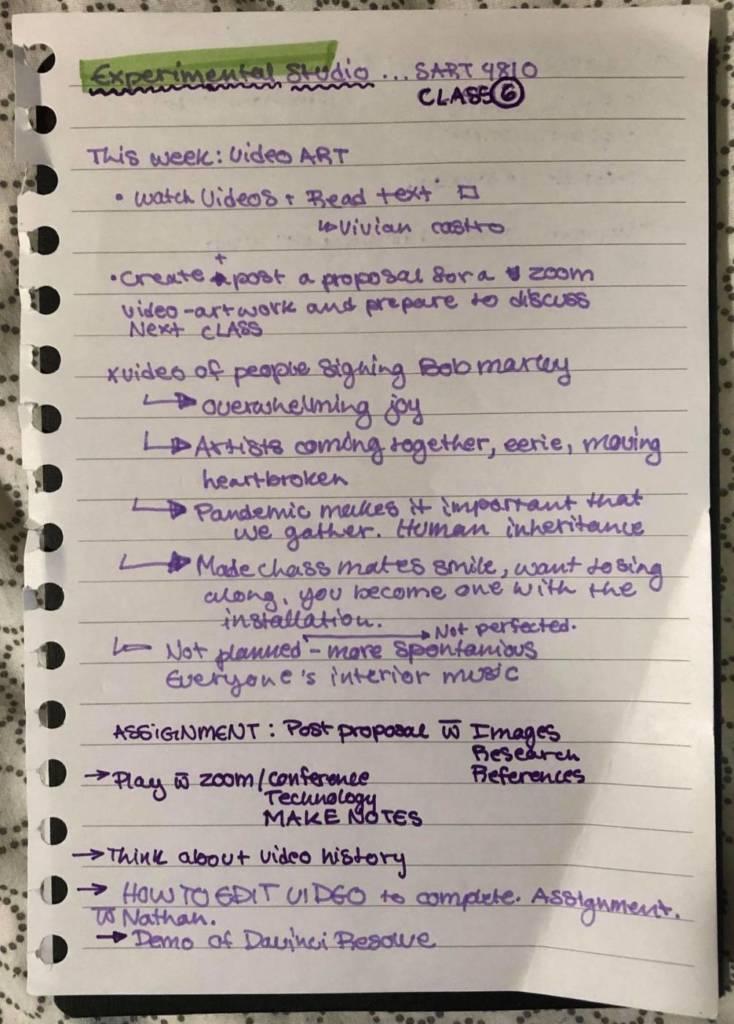
Videos on Week 6 Notes:
- The idea of stop motion and DADA artists making films appeal to me more than the ones where taking happens, I find I have done a few drawing videos and simplistic object videos in high school (in a similar course to Experimental called NonTrad). I also have a love for posters and the type of Typography/colour layout used for band and museum posters.
- I was volunteering at an art space in a hospital a few years ago and one of the staff had made these stop motion films they played for the youth in the program. Although the set ups/framing were static the movement on the screen made these youth jump for joy, they loved the old film sound and how the machine projected the images on the wall. The staff member had videos on everything on monsters to one completely with cut up letters that just made weird sounds as it zipped along the projected image. Personally, it was more the reaction to the videos from the youth in the room more than the videos I looked at but they were catchy enough that they stayed in my mind for at least a couple months after. That would be something to think about instead.
- The work of Candice Breitz especially the Madonna video resonates with me. Out of all the singling I found myself paying close attention to the parts where there was a pause or only one person was signing during the instrumental, almost as if I was specifically looking for the mistakes rather than the harmonious moments.
- Pipillotti Rist, Open My Glade made me fell unconformable, had the same felling of the people that do to asmr of eating honeycombs or squish bread with their faces…
Proposal Ideas
IN CLASS SHARE FEEDBACK (on proposal idea)
- Multiple perspectives, from low or human angles (socks perspective or under the table or on a self).
- Have editing be the key, displaying the videos side by side or distorting the images or sound. Add something warped.
- Have a visual rock (anker) to each video in view, do something in the frame thats less mundane although the idea of a Zoom call is normal and integrated in our daily lives.
- Possibly: have multiple people do the same thing, each videoing themselves in two perspectives.
- My first idea plays along with the idea of having two recorded videos, presented together side by side or spliced together, of a zoom call but with no one on screen or at least them (me) in the background.
- I thought about having an angle that was not the face, I’d choose another body part like the elbow or feet. It would be interesting to record myself with my daily actions while ‘in class’ but not having the desired angle, showing what others would see of they were in person in my same space, i.e. chair shifting, making food, playing with my hands, or clipping toenails or movement of my feet during class, etc.
- As a thought progress continuation – I find that when logging off after a class there is about an hour where I try and get mu basic needs met before more family members come home, this means, cleaning up, making food, setting the dinner table, dancing in the kitchen, these are things that are a common occurrence recently but still a part of me time, a time to ‘Zoom out’ and be happy with no screen and no-one around to invade and disrupt my thoughts.
- The camera angles wouldn’t be anything dramatic but I think I lower angle would be great, like sitting on the floor.
- I don’t want it to have any facial recognition just moment, almost like the quietness that you experience in a library, you can hear rustling, humming, or headphone music playing, as much as this is a video project I was thinking more of a sound scape.
- The idea of it being voyeristic without the personal intimate aspects is the direction I want to go. I am hoping to use my kitchen as the location while not having the screens on the same shot together.
- If I wanted to push it I could think about the idea that our phones are always watching us, and listening but I’m not sure of I want to go that far. I quite liked Nevan’s piece with her lying in bed, but without the sed up unless it looks better that way.
- IN terms of presentation. I was thinking either displaying both side by side with a black screen or have both play over a still image from the shot but blurred to not interfere with the noises in the video.
- The technology I might use is Zoom or Facebook… I will let it run for the half an hour and leave it to chance with my animals roaming around.
- My influences with this are really the Lo-fi sound scapes available on youtube or the study with me videos, although I think how the videos will be presented will be the most important aspects of it rather than the video themselves. I’m open to suggestions.
- Below are some videos and images I found for inspiration:
- breakfast. [jazz hop / lofi / chill mix] – https://www.youtube.com/watch?v=zOPn5meO3lE
- Open Window New York City Soundscape at Night – https://www.youtube.com/watch?v=Vg1mpD1BICI
- Recording a 3D Soundscape of a Winter Forest (with 3D Binaural Audio) – https://www.youtube.com/watch?v=o83eP_o5ZOU&t=202s [Start at 3:44]
- The Western Soundscape Archive | Preserving nature’s soundtrack – https://www.youtube.com/watch?v=vueZOquE4qc
3. Here is a sample drawing of where I could put the two computers and what they would see: (I’m not the best at drawing maps, I will add some freeze frame images when testing out his idea soon.)

ASSIGNMENT 4 – SOCIAL DISTANCING PORTRAITS + Adad Hannah REFECTION
Rules for making his Instagram video clips:
- Each subject is framed in the center of the shot. He also posts the uncropped video version in his Instagram stories.
- He is standing at least 5 meters away with a long lends to capture onto the subject and not the background.
- How they are presented on his Instagram, you can see the whole body(ies) even in the thumbnail.
- He either angles them to look indirectly at the camera or depending on the pose i.e. the BLM Marcel video has them looking directly at the camera.
- The Vancouver sun’s article shares that he likes taking the video and a still image at the same time, it would be nice to see bother presented in the same post.
- His posts change with the government guidelines and the information that comes out about safety precautions one should take to not transmit the virus. In the beginning, you can see that no one is wearing a mask up until March 22nd where Jaya is posing with their skateboard outside.
- He also doesn’t shoot groups together unless they are from the same household.
- At first, he tries to have the pose of the person to be natural to them and relate to their statement. For example, Qadir (March 28th) with his boxing gloves, standing in an action pose which complements his statement about staying positive, staying in shape and supporting the front line workers who are doing a wonderful job. Another example is Melissa, a teacher, she holds an inviting stance, as she is excited to welcome her students back to school, who have been desperate to connect with each other.
- Some of the backgrounds he uses in relation to where he asked the person to take their photo have reference to the pandemic, either congregating in small groups all the park. Either warned by the city not to… (A recent news story in Toronto about all the people that were in Trinity Bellwoods Park, springs to mind). Or capturing protesters for the black lives movement has an impactful statement of people coming together but still distancing and wearing their masks.
- When looking at the layout of the Instagram feed, He posts the images from the same location or area one after another. For example, the videos of the beach trip are together and the park photos are together. On some occasions, there is music attached to the video but most have the natural sound.
- One of my favourites is Kelly and Aria (Oct 9th). The music is haunting but seeing her eyes move adds life into the image.
- His approach is similar to the Humans of New York Instagram but with more originality in the poses. He shows a snippet of what the last 6 months have been for many while not giving too much away. Fundamentally we are all going through the same thing no matter or political opinion, or race, class or age, just like passing a stranger on the street and giving them a discrete once over as we pass, there is now a sense of understanding and care we have for one another. I do hope that continues.
Social Distancing Video Portrait 1 (I have no choice, but I’m lucky edition)
—
Alan
—
“Myself it’s a risky job. I have been working in a convenience store since middle of March when Covid 19 started. In my store, I was serving all customers. So far I’m lucky and safe. I instructed all customers to wear a mask when entering in my store. I have no choice continuing this, my job. Until our country finds the right medicine for Covid 19, as a Canadian I try to do my best in the community. Thank you.”
Social Distancing Video Portrait 2 (Mounting COVID numbers; is change in the wind edition).
—
Laurie
—
“The last 6 weeks have been full of change causing internal anxiety for the students and the teachers. It seems like procedures shift daily and take up space in my brain. The COVID numbers are mounting in the city and businesses are closing down once again. I fear that I will be back in my kitchen staring at a screen all day trying to make the students buy into the lesson. But Casinos are opening up in Ontario today…”
Notes from Maggie: As of the end of this month, Alan, will be selling the store. He has been the owner on and off for many years and will be missed.
ASSIGNMENT 3 – BANNER + canadianart ESSAY
Class Notes

Photographs

*** This is my knowledge of this area. I’ve had a few opportunities to work with the kids in the area, but I’m still an outsider. I don’t live in the residing towers. Here is my perspective from a community-building/engagement perspective.
- This area is residential, it is filled with children and families of all ethnicities and cultures. It as sandwiched between Riverdale, Cabbage Town, Bay St area and the Don Valley.
- The area has mid to lower-income households.
- Lots of families live in small apartments, mainly 8 floors tall and lower.
- There used to be a patch of green space with an abandoned house here.
- Nearby there is one school playground, during the summers it is packed with children. That is the only main space to play in large groups within walking distance of all the apartment buildings.
- What’s going up on this corner is a massive building, has no connection to the area, only affordable to few, not all.
- The construction safety walls has the vision of art made by community programs and artist but does not reflect what is being built, or what it lacks, in terms of supporting the community, other than the chain restaurants nearby.
- Saftey walls have repeating pictures of lush green trees, vendors, humans and characters enjoying being outdoors, etc.

Materials: White printer paper, red dollar store gift bag repurposed paper and cotton string (in reference to cotton socks worn by construction workers).
References: https://canadianart.ca/essays/dirty-words-interesting/ https://inps.net/graphics/sites/default/files/pdf/MTO-Book-5.pdf https://en.wikipedia.org/wiki/Stop_sign


ASSIGNMENT 2 – TEXT AS ART
Class Notes
Class discussion about last week’s blog post: Book Stacks
Class discussion notes: Katachdourian’s love of the physical notion of the book. She enjoys using their feel in her hands, the shape, colour and texture. She uses the material presence of the books.
- Look closely at things that we know so we know what they are.
- Discoverists in our own libraries.
Week Two – WordPress Assignment: Looking text as art images. Choose two images and write about… How they use text (size, shape, letter accents, the composition of the text on a surface). Different media – billboards, books, lights, installations? How the work is crafted. How is the work intended viewer. What is the meaning and what media works well with the message experienced of the viewer. How the text stands in for the artwork and the affect it has? Use letters and words as the material itself.
Reading/Artwork Response
The two art pieces I have chosen to write about are John Baldessari, Tips for Artists Who Want to Sell, 1966-1968 and Joi T. Arcand, Northern Pawn, South Vietnam, 2009.

The typography within John Baldessari’s, Tips for Artists Who Want to Sell, 1966-1968, uses westernized and European references. The material and dark beige colour it’s printed on has looks like either a store sign written by the owner on a sample size a 8.5×11 sheet of paper. It is similar to the work of Sol LeWitt as he gives a set of instructions. Although not numbered on the page, the bold list spots next to each paragraph gives each text piece a surge of attention to each first word of the paragraphs. If he had created the piece with text only, no special characters, it would make the words like they hold less importance. I would not be enticed to read the whole of the text but only read the first and last sentence.
He is addressing a target audience of creators and mark-makers. He uses impersonal text, i.e. no tales on the ends of his letters, yet does not go for the obvious Ariel or Calibri. There is a formality to the piece, like a professor giving an assignment sheet to students. The text in all capitals adds to this formality, and showcases everything written below the initialized but bolded title. This gives importance to the text. The text is also selective in its word choice. Unlike Arcand’s photograph, there is no visual stimulation. It does not dictates a location or want the viewer to imagine a future that could be within reach. European/westernized representations are used with not collaboration with different cultures or norms. Joi T. Arcand work below, uses the Cree written language as a cultural statement taking us out of the European norm.
John Baldessari doesn’t want the artists who use this text as instructions to fail or loose focus. He aims to have a controversy free result from this work. The text also has little connection with art history other than the Christian Madonna reference. Yet on the other side, he chooses to state that masculine and strong imagery like rosters and bulls sell more. A note to the bias found to society?
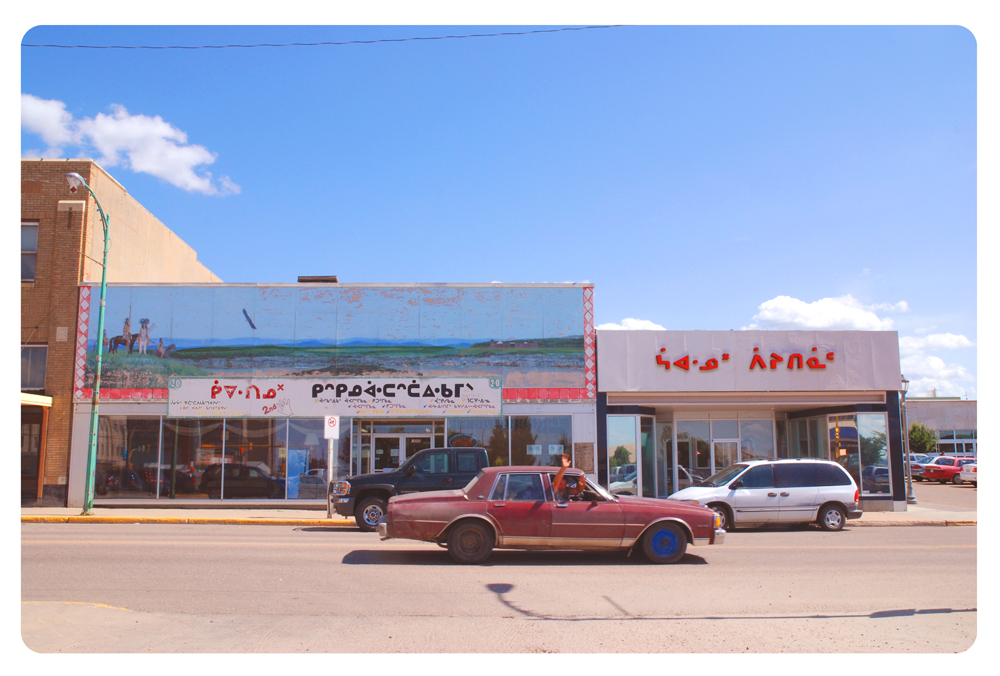
Joi T. Arcand’s photograph and series Here on Future Earth is a contemplative and exciting look into text, how it shapes our surroundings and our perception of one’s local environment. As the website: canadianart put it, her implementation of exchanging English titles and labels of storefronts, buildings and signs for text in the Cree language, “changes the visual landscape” and challenges how we conceive the geographical location we reside in. Arcand changes the meaning of each logo or title of building; but creatively uses a ‘painterly’ format by understanding the breakdown of syllables and how each letter looks in comparison to one another. How the text sits and shapes its surroundings.
So often, we are over saturated with the same labels and logos of companies that we are able to identify a sign just by its colours such as McDonalds, Starbucks or even our favourite book stores. Especially if we don’t travel by foot, the passing of buildings or storefronts become a large blur. The language, the font, colour or letter shape can influence what we think of an area. For example, I live in Toronto, and near me there is a section of the Danforth called Greek Town. The sign hanging over the street when you enter and the constant shades of blue stripes on each pole give the perception that the area is full with Greek owned restaurants and stores. In actuality, the population of the area is very diverse, few Greek people actually live in the area because the Greek diaspora in Toronto has sped its wings. However one would not know this from the visual representation that is prominently shown on the Danforth when one is passing by. Greek Town feels “Greek” in its visual representation.
Joi T. Arcand’s Northern Pawn uses text and the sculptural aspects in both her painted words and the commercialized plastic material as a transportation vessel to get her new norm across. She brings you forward and backwards in time. For example, she make’s a ‘lens’ to show how land is governed by language, how changing the language changes the political power relationship. The syllables allow us to envision the past and who used to live or still lives in the town. Who has the ownership of the businesses, are they power present or power past? Arcand strives for a non-western outlook in language/letter representation. This allows the normalization of this practice and perspective. Hopefully choosing language alternatives when labeling will further more diverse positions in art and society. It is well known that many languages, some old dialects or languages that have a small population of speakers are slowly being lost in the swath of the majority speakers, therefore, Arcand’s photographs revitalize and preserve language by increasing its visibility. The affect these photographs is refreshing, like visiting another country, helping one to rethink the norm. There is a sense of satisfaction in seeing marginalized cultures and language integrated into westernized civilization as if they were the norm or not. It is an interesting mind game. We need to see more non-majority languages represented in our society on a daily basis, normalizing Indigenous languages, changing power relationships. Common use of any language both written and spoken is important for education of the general public and the visibility of marginalized peoples.
References
https://en.wikipedia.org/wiki/John_Baldessari
https://imageobjecttext.com/tag/john-baldessari/
ASSIGNMENT 1 – BOOK STACKS
Photo One – For Whom The Bell Tolls
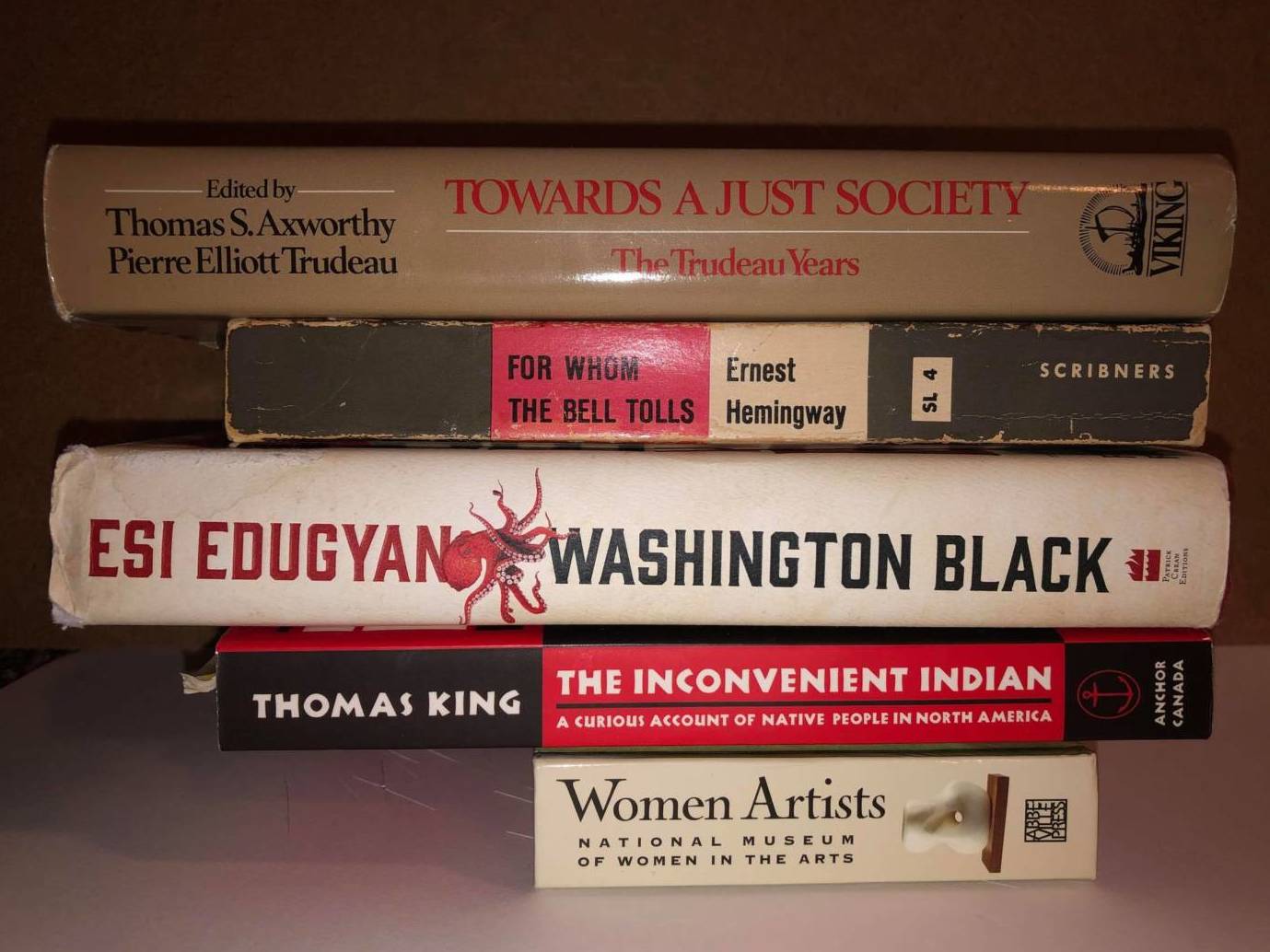
The first book stack assembled is a combination of books I own and my parent owns. I wanted to create a stack that commented on the events that happened over the summer without delving too deep. I identify as a white person who has ancestral ties to both Métis and colonial history. This means I should and do care about the racial inequalities that are currently rearing their heads in the general conscience of society. Too bad some think racism and inequality are new and not the ongoing societal bias of our colonial past. The last book is of woman artists, I thought it would be an appropriate nod towards the feminist march that took place in 2019. Our library is diverse and thought-provoking, reflecting the controversial richness of the world we inhabit. Each day on social media there’s a new petition or event to attend, it can be hard to not get lost in the melee. I wanted to showcase what I’ve been witnessing and self-educating on with my peers.
Photo Two – Fashion is…

This second book stack is an opinionated piece. In my personal opinion, I am on the fence about how art is displayed in galleries. The Art’s monetary value is tied to the name of the artist, word of mouth and the marketing machine that pushes the trinkets being replicated from the original art without sustainability. Funnily enough, this was an ongoing topic of discussion two years ago when I took Dave Dyment’s class. Yes, I love art galleries and museums, I am guilty of buying magnets, socks and posters of famous art pieces, but I do believe there is a point where the societal saturation of a painting or sculpture goes too far. But on the other hand, I also believe that art should be for the general public and not locked away in someone’s vault. As an artist who makes and consume art, I’m still trying to work out my feelings toward the subject.
Photo Three – Comfort Food…
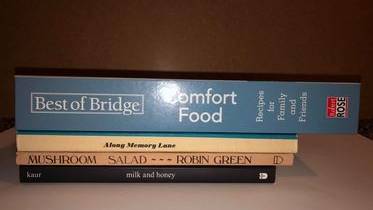
This last stack of books is a nod to food and its comfort. After posting the picture I do harbour some reluctance towards the recipe book to the stack, it’s size and content don’t match the other three but if taken away there wouldn’t be a set theme. In this case, compared to the other two stacks I was caught in the sphere of family dinners and diner parties. There is pathos here as the parties are not on the menu these days.
READING and REFLECTION (Class Notes)
Nina Katchadourian’s Only Yesterday photo from the series: Kansas Cut-up which is part of the Sorted Book Project is an interesting example of an intuitive assembly. It reminds me of moving plastic letters or word magnets around the surface of my fridge to make a sentence or finding creative word associations in a novel by erasing/covering sentences until you are happy with the end result… She is creating a story, moreso poetry with titles of books. Katchadourian uses the physical qualities, title relations, lists and blocks of colour. She pays close attention to book cover typography and backgrounds of covers to mismatch these stacks from the libraries of many, including the personal library of Willam S. Burrows.
Understandably, from the video, Sorted Books | Nina Katchadourian we learn that she has an extensive process of sorting, labelling and physically moving the book stacks around until she is content with the end result, this may take hours or just a few minutes to put together. As she sorts through a library she learns about the person through their use of books.
- How many times they may have picked up the book to re-read?
- The condition of a book: Is the spine cracked in multiple places?
- Are the pages ripped?
- Are their notes or sticky notes peaking out the sides?
- How has the book owner organized the books on the shelves? By colour? Most read? Least enjoyed?
From there, she takes these books and tries to create a profile of the person. Out of all the photographs presented on the assignment page, I was drawn towards her Only Yesterday, 2014 photograph.

Pictured above: Only Yesterday
C-prints, each 12.5 x 19 inches, 2014
Only Yesterday, I Left My Grandfather's House, Flashback, I Left My Grandfather's House, I Left My Grandfather's House, Flashbacks, Flashbacks.
Visually, one can see that she has assembled these books based on having multiple copies, the size and colour as well as their composition. Reading from the top book to the bottom, the text holds more that one linguistic inflection when reading these titles aloud. The first two books set up the story while the repetitive titles and vibrancy can make the viewer, me, understand it’s urgency and prominence. To be able to relate to why Burrows had various amounts of the same book and multiples is a mystery, yet may have insight into his own body of written work.
He was known for beat literature and paranoid fiction. All things considered, he was writing and creating in a post-war era, the 1950s, where PTS was not uncommon for many people in America who had been affected by WWII. Therefore, Katchadourian’s process of assembling this particular book stack, in my eyes, is an ode to the 1950s and Borrow’s body of work.
Side Note: Out of curiosity I wanted to see if this particular book stack had any colour relations to his geographical location and Katchadourian’s series title. Burrows spent the latter part of his life in Kansas. The city’s colours are red and gold and Kansas State’s colour is royal purple (shades of purple). Just an interesting thought as to why he owned the books (depending on when he bought them), other than for their content. Just like in Guelph, seeing the school colours on a daily basis may draw you towards buying something with similar colours…
* * *
The second Photograph from the assignment page I would like to unfold is the work of Dave Dyment, ONE BILLION YEARS [PAST AND FUTURE], 2012.

A collection of books pertaining to the past and future, arranged chronologically from One Billion Years Ago to The Next Billion Years.
As a student at the University of Guelph, I had the opportunity to take two of Dave’s classes (Extended Practices 1 and 2). Knowing his lecture style and opinions purely based on what objects he willingly shared with his students during class hours gives me some insight into his work. Along with the multitude of photographs he collected and commented on during our weekly PowerPoint presentations, I have to say that this artwork (pictured above) is not unusual and is consistent with what I learned about in class. He enjoys collecting, both functional and sometimes impractical objects, he always took great care in how he sorted through bookstores or websites to find the one piece that was missing from his home collection and needed for his work. He is meticulous in maintaining and preserving their quality over time. His art world connections aided in his searches. He is always direct with his thought processes/explanations and has no qualms letting you know when there was a piece or artist he did not care for. I believe the same type of time and focus went into the creation of ONE BILLION YEARS.
Listed below is the ways he may have chosen these particular books:
- Quality and value to himself or the artist who made the product (i.e. the limited additions available and their uniqueness).
- If the book was written by another artist he was friends within the art community, he’d put in the effort to buying it.
- Colour doesn’t overwhelming matter within this composition, it’s more the text he was focused on, to stick to the pattern of past and present.
- After further analysis there is a slight colour pattern to his work, the three prominent colours are red blue and shades of yellow, yet this may be accidental due to it having no correlation to the text on the spines.
- In this case, the content may have some relevance but for appearance sake, I don’t think it mattered. Nor would the print date as long as it is relatively close to the first print release. Again, he favoured limited editions of objects.
- I hypothesize that he may have already owned some of these books and put great effort into sourcing these books in person and curated the covers. He may have also exchanged books every so often to be more inclusive of eras and locations (America to Scotland).
- Lastly, from the photograph, he chose all used books, the spines are cracked, edges dented and worn embossed titles.
Other than his organization of books from one ara to another and the slow visual uniformity of the printing press sizes, I don’t see any major correlation to the language of books and no familial ties he represents within the work. Yet… circling back to the uniformity of the books based on the future half of his arrangement (right side) this can be a connected by itself.
- With access to the internet, we now have lost some of our creative nature as an individual artist because the world is so interconnected, whatever we make as artists will be or has been a copy of someone else work.
- The new global rules on how tasks are completed or guidelines for making art are drawbacks to spontaneity, i.e. book sizes…
In conclusion, my theories on how he assembled the books based on uniformity and societal interconnection/loss of creativity, would be an interesting avenue to explore.









